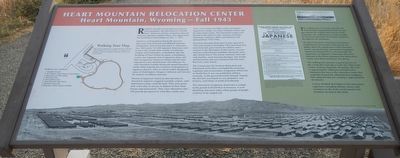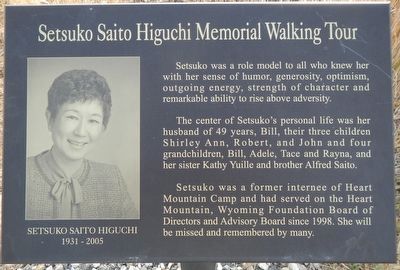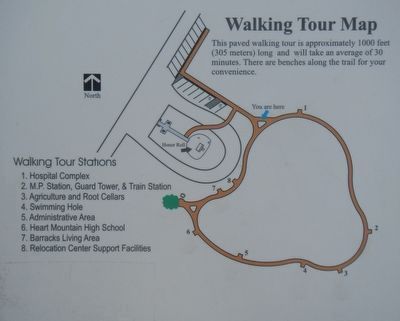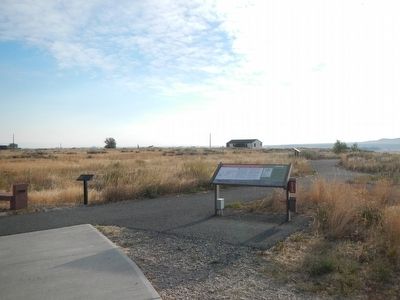Near Ralston in Park County, Wyoming — The American West (Mountains)
Heart Mountain, Wyoming - Fall 1943

Photographed By Barry Swackhamer, September 14, 2015
1. Heart Mountain, Wyoming - Fall 1943 Marker
Captions: (top right) Looking down Avenue E towards Heart Mountain; (center right) This poster was issued by the Western Defense Command and the Fourth Army Wartime Civilian Control Administration in response to the Executive Order 9066 signed by President Franklin D. Roosevelt of February 19, 1942,; (bottom) View of Camp looking toward McCullough Peaks.
Initiatives and legislation during the previous forty years had restricted or prohibited Japanese immigration, land ownership and U.S. naturalization. Still nearly 127,000 Japanese Americans were living in the United States mostly in California, Oregon and Washington. Immediately after the bombing of Pearl Harbor by Japan, a mandatory curfew was imposed, first on Japanese aliens and then on Japanese American citizens and all were required to carry identification. On February 19, 1942 President Franklin Roosevelt issued Executive Order 9066 ordering the exclusion of all persons of Japanese descent, alien or citizen within designated areas of Washington, Oregon, California and Arizona for reasons of military necessity.
Persons of Japanese American descent were instructed to report to assigned assembly centers, until interment camps could be built. They were given only a few days to secure or dispose of their land, houses and possessions. They were allowed to take 100 pounds per person or what they could carry.
There were sixteen assembly centers, ten Justice Department camps, six citizen isolation centers and ten interment camps. The interment camps were located in the states of Utah, Arizona, Colorado, Wyoming, California, Idaho and Arkansas and operated from 1942-1946.
The Heart Mountain Relocation Center opened in 1942 and closed in November 1945 and all persons were removed, given twenty-five dollars and a rail pass to the destination of their choice. Former internees suffered great hardships during the years after World War II. The former internees often met with hostility, acute housing shortages, loss of jobs and businesses and were forced to start life anew. Recovery came slowly.
The Commission On Wartime Relocation and Interment of Civilians concluded the exclusion, expulsion and incarceration of Japanese Americans in World War II was not justified by military necessity, as the government had claimed, instead the decision was based on race prejudice, war hysteria, and failure of political leadership.
The interment of Japanese Americans is unique to the period of World War II; however, it is of disturbing relevance today when groups of people continue to be singled out.
Side-bar on right
The walking tour is on land owned by the United States Department of the Interior and operated by the United States Bureau of Reclamation. The walking tour is made possible by the Heart Mountain, Wyoming Foundation through
private donations.
The Heart Mountain Wyoming Foundation is established to memorialize and educate the public about the significance of the historical events surrounding the internment of Japanese Americans during World War II, and especially the experiences of Japanese Americans who were interned at the Heart Mountain War Relocation Center near Heart Mountain, Wyoming.
The walking tour presents a partial pictured of the events that took place in the War Relocation Center at Heart Mountain, Wyoming. The trail is approximately 1000 feet in length and is situated in the area of the relocation center that originally housed the Administration buildings. The estimated time for viewing is approximately 30 minutes.
A more detailed description of the internment experience including military service and resistance to the draft and be found in the brochure at this kiosk.
Erected by Heart Mountain, Wyoming Foundation.
Topics. This historical marker is listed in these topic lists: Asian Americans • War, World II. A significant historical date for this entry is February 19, 1942.
Location. 44° 40.229′ N, 108° 56.956′ W. Marker is near Ralston, Wyoming, in Park County. Marker can be reached from Road 19 near Lane 15, on the left when traveling west. Touch for map. Marker is at or near this postal address: 1474 Road 19, Ralston WY 82440, United States of America. Touch for directions.
Other nearby markers. At least 8 other markers are within walking distance of this marker. Heart Mountain Relocation Center Honor Roll and Flag Pole (a few steps from this marker); Hospital Complex: (within shouting distance of this marker); Daniel K. Inouye (within shouting distance of this marker); Relocation Center Support Facilities (within shouting distance of this marker); Norman Y. Mineta (within shouting distance of this marker); Barracks Living Area: (within shouting distance of this marker); Heart Mountain World War II Memorial (within shouting distance of this marker); Heart Mountain Relocation Center Memorial (within shouting distance of this marker). Touch for a list and map of all markers in Ralston.
More about this marker. Heart Mountain Relocation Camp is located off of the Powell Highway (U.S. Highway 14A) about 6 miles south of Ralston. This marker is located on the Setsuko Saito Higuchi Memorial Walking Tour near the Heart Mountain Relocation Center Memorial Park.
Additional keywords. Japanese American internment

Photographed By Barry Swackhamer, September 14, 2015
4. Dedication plaque for the Setsuko Saito Higuchi Memorial Walking Tour
Setsuko (1931 - 2005 ) was a role model to all who knew her with her sense of humor, generosity, optimism, outgoing energy, strength of character and remarkable ability to rise above adversity.
The center of Setsuko's personal life was her husband of 49 years, Bill, their three children Shirley Ann, Robert, and John and four grandchildren, Bill, Adele, Tace, and Rayna, and her sister Kathy Yuille and brother Alfred Saito.
Setsuko was a former internee of Heart Mountain Camp and had served on the Heart Mountain, Wyoming Foundation Board of Director and Advisory Board since 1998. She will be missed and remembered by many.
The center of Setsuko's personal life was her husband of 49 years, Bill, their three children Shirley Ann, Robert, and John and four grandchildren, Bill, Adele, Tace, and Rayna, and her sister Kathy Yuille and brother Alfred Saito.
Setsuko was a former internee of Heart Mountain Camp and had served on the Heart Mountain, Wyoming Foundation Board of Director and Advisory Board since 1998. She will be missed and remembered by many.
Credits. This page was last revised on June 16, 2016. It was originally submitted on December 1, 2015, by Barry Swackhamer of Brentwood, California. This page has been viewed 420 times since then and 10 times this year. Photos: 1, 2, 3, 4. submitted on December 1, 2015, by Barry Swackhamer of Brentwood, California.

